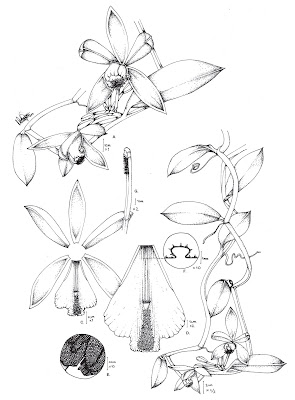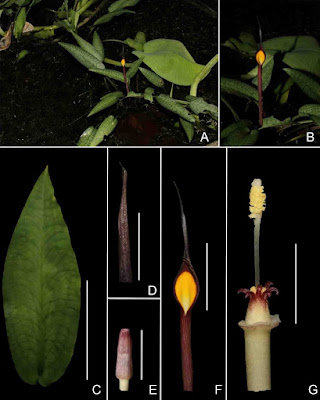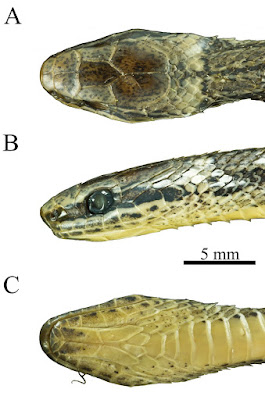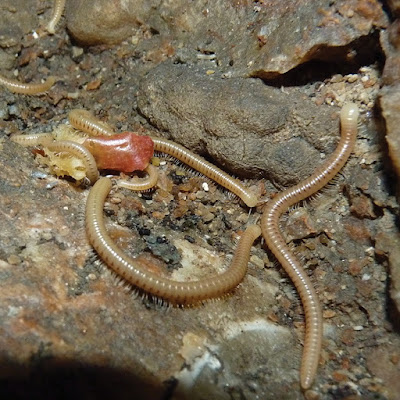[Most Recent Entries] [Calendar View]
Tuesday, August 14th, 2018
| Time | Event | ||||||||
| 4:09a | [Fungi • 2018] Lactarius nigricans & L. verrucosporus • Two New Species of Lactarius (Russulaceae) from southern China
Abstract Two new species of Lactarius from Dinghu Mountain, Guangdong Province in southern China were described based on both morphological characters and phylogenetic analysis of internal transcribed spacer (ITS) sequences. Lactarius verrucosporus sp. nov. is characterized by reddish brown pileus with white and decurved margin, pale cream lamellae, globose to subglobose basidiospores with isolated warts, thin pileipellis composed of globose subterminal cells and inflated terminal elements. Lactarius nigricans sp. nov. is recognized by greyish brown pileus, beige lamellae, amyloid basidiospores with high ridges, subcylindrical to subfusiform caulocystidia, thick pileipellis with long terminal cells. Both molecular and morphological analysis consistently confirm that L. verrucosporus and L. nigricans belong to Lactarius subgenera Russularia and Plinthogalus, respectively, and both species are distinct from all described species of these two subgenera. The morphological differences of these two novel species with their closely related taxa are discussed. Keywords: Fungi, Lactarius, new taxa, phylogeny, taxonomy Geng-Shen Wang, Yu Song, Jing-Wei Li, Shi-Yao Xia and Li-Hong Qiu. 2018. Lactarius verrucosporus sp. nov. and L. nigricans sp. nov., Two New Species of Lactarius (Russulaceae) from southern China. Phytotaxa. 364(3); 227–240. DOI: 10.11646/phytotaxa.364.3.2 | ||||||||
| 6:15a | [Botany • 2018] Vanilla denshikoira (Orchidaceae) • A New Species of Vanilla from the North West Amazon in Colombia
Abstract A distinctive species, Vanilla denshikoira, is described from the North West Amazon, in Colombia, within the Guiana Shield region. The species has morphological features similar to those of species in the Vanilla planifolia group. It is an important addition to the vanilla crop wild relatives, bringing the total number of species in the V. planifolia group to 21. Vanilla denshikoira is a narrow endemic, known from only a single locality, and highly vulnerable to anthropological disturbance. Under IUCN criteria it is categorized CR. The species has potential value as a non-timber forest product. We recommend a conservation program that includes support for circa situm actions implemented by the local communities. Vanilla denshikoira Flanagan & Ospina-Calderón sp.nov. Diagnosis:—The new species is similar to Vanilla aspericaulis, V. capixaba, and V. cristagalli, sharing with them a concave lip base, a more or less tri-lobed lip, and a conspicuous tuft of trichomes on the recurved lip apex that is connected to the penicillate callus by a central area of tuberculate papillae and trichomes. The new species may be easily distinguished by the external longitudinal canal running from the lip base to the apex of the reflexed midlobe, and the papillae and elongated trichomes on the ventral lip surface covering the tuberculous keel and central veins from the base to the penicillate callus. Etymology:— The epithet refers to the name of a female figure in the mythology of the Puinave indigenous community, native to the department of Guainía, Colombia. The name ´Denshikoira´ translates in English to “perfumed woman”. Denshikoira, also known as the Princess Inírida, occupies a central position in Puinave culture, with her myth representing the freedom and equality of women. The name was chosen by Lucy Teresita García Agapito, a member of the Puinave Indigenous community of Remanso-Chorrobocón. Distribution and habitat:— Vanilla densikoira is known only from the two fertile plants in the Type locality, the first close to the River Inírida, in seasonally-flooded, medium-height (between 10–20 m), open (< 60% canopy cover) forest at 100 m elevation, and the second also in medium-height, open forest on an igneous outcrop, at 265 m elevation. The floristic composition of these sites is notable for the presence of the following tree species: Clusia columnaris Engler in Martius (1888: 432), Casearia javitensis Kunth in Humboldt, von Bonpland & Kunth (1821: 366), Tapirira guianensis Aublet (1775: 188), and Chrysophyllum bombycinum Penn (1990: 588). Conservation status:— Vanilla denshikoira has an apparent highly restricted distribution, apparent rarity, and both known individuals are highly vulnerable to human activities. Based on the IUCN criteria the species is categorized as Critically Endangered-CR: A3c; B1ab (i,ii,iii,iv). Nicola S. Flanagan, Nhora Helena Ospina-Calderón, Lucy Teresita García Agapito, Misael Mendoza and Hugo Alonso Mateus. 2018. A New Species of Vanilla (Orchidaceae) from the North West Amazon in Colombia. Phytotaxa. 364(3); 250–258. DOI: 10.11646/phytotaxa.364.3.4 | ||||||||
| 7:39a | [Botany • 2018] Cryptocoryne joshanii (Araceae) • A New Species Serendipitously Discovered in Sulu archipelago, Philippines
ABSTRACT A new species, Cryptocoryne joshanii Naive & Villanueva, from the island of Basilan, Philippines, is herein described and illustrated. It is comparable to C. usteriana, but differs significantly in having lanceolate leaves, acicular, outwardly recurved, purplish red stigmas and an erect spathe limb. Information on the geographical distribution, ecological data, phenology and conservation status as well as an identification key to the Philippine Crytocoryne species are provided. KEY WORDS: Aroids, Basilan, Cryptocoryne, Mindanao, New species, Sulu archipelago, Philippines. Cryptocoryne joshanii Naive & Villanueva, sp. nov. Type: PHILIPPINES, Mindanao Region, Sulu Archipelago, Basilan Island, elev. 850 m, May 2013. R.J. Villanueva 001/2017 (holo HNUL, iso USTH) - Full locality data withheld owing to the risk of potential exploitation of wild populations for commercial purposes. Diagnosis: Somewhat similar to C. usteriana in the spathe, but it differs significantly in having an acicular, outwardly recurved, purplish red stigmas and an erect smooth limb. The leaves are clearly different by being smooth, light green with markings. Distribution: This Philippine endemic species has only been observed and documented in Sulu archipelago, particularly on the island of Basilan, Philippines. It is very local and despite of extensive survey along the stream and in other areas, it occurs only on the site where the sample was collected. Ecology: The population of this species was found growing in a slow flowing montane forest stream in the interior of Basilan Island. The forest is relatively dense with only 40% sunlight reaching the stream bed. The population grows on volcanic rock in the stream several meters from the waterfall at elevations of about 800– 1000 m a.s.l. The roots and rhizomes were noted to penetrate deep into the pebble/sandy substrate rich with decaying leaves. The entire clump was submerged or partly submerged with leaves exposed. Eponomy: Named after Joshan Vlad A. Villanueva, son of the discoverer/second author. Notes: Based on overall morphology, Cryptocoryne usteriana, appears to be the closest ally of C. joshanii. However, C. joshanii differs significantly in having these following characters: lanceolate leaves, an erect apex of the limb and in having acicular, outwardly recurved, purplish red stigmas. Mark Arcebal K. Naive and Reagan Joseph T. Villanueva. 2018. Cryptocoryne joshanii (Araceae), A New Species Serendipitously Discovered in Sulu archipelago, Philippines. Taiwania. 63(3); 248-250. DOI: 10.6165/tai.2018.63.248 | ||||||||
| 7:50a | [Herpetology • 2018] Rhadinaea nuchalis • A New Rare Species of the Rhadinaea decorata group (Squamata, Colubridae) from the Sierra Madre del Sur of Guerrero, Mexico
Abstract A new species of the Rhadinaea decorata group is described based on two specimens from the Sierra Madre del Sur, Guerrero, Mexico. The new species differs from all other members of the genus Rhadinaea by having: eight supralabials; 149–151 (male) ventrals; 63–77 (male) subcaudals; two large pale nuchal blotches, forming an incomplete collar that occupies two scales laterally and is bissected along the dorsal midline; a postocular pale marking consisting of a well-defined, narrow line beginning behind the upper posterior margin of the eye and extending posteriorly nearly horizontally until connecting with the nuchal blotches; and the dark ground color of the flanks extending to the lateral portion of the ventrals. The large nuchal blotches distinguish the new species from the other members of the R. decorata group, except for R. cuneata and some individuals of R. hesperia (pale nuchal marking one-scale wide in R. marcellae, absent in the other species). The condition of the postocular pale marking distinguishes it from R. cuneata and R. hesperia (postocular pale marking wedge-shaped in R. cuneata, not connected with the pale post-cephalic markings in R. hesperia). Furthermore, the number of subcaudals and the coloration of the lateral portion of the ventrals distinguish it from R. omiltemana and R. taeniata, the remaining congeners found in Guerrero (85–90 in males of R. omiltemana and 91–121 in R. taeniata; dark color of the flanks not reaching ventrals in the former species, occasionally and faintly in R. taeniata). Additionally, a new combination for R. stadelmani is proposed. The new species is the first described in the genus Rhadinaea in more than 40 years. Keywords: Description, reptile, snake, systematics, taxonomy
Rhadinaea nuchalis sp. n. Diagnosis: A colubrid snake of the Rhadinaea decorata group (sensu Myers 1974) that may be distinguished from all other members of the genus Rhadinaea by the following combination of character states: eight supralabials; 149–151 ventrals in males; 63–77 subcaudals in males; presence of two large pale nuchal blotches, forming an incomplete collar that occupies two scales laterally and bissected along the dorsal midline; postocular pale marking consisting of a well-defined and narrow line beginning anteriorly behind the upper posterior margin of the eye and extending posteriorly nearly horizontally until connecting with the nuchal blotches; and ground color of the flanks extending to the lateral portion of the ventrals. Etymology: The specific name nuchalis comes from the Latin nucha, meaning nape. It makes reference to the large nuchal blotches present in the new species.
Uri Omar García-Vázquez, Carlos J. Pavón-Vázquez, Jean Cristian Blancas-Hernández, Epifanio Blancas-Calva and Eric Centenero-Alcalá. 2018. A New Rare Species of the Rhadinaea decorata group from the Sierra Madre del Sur of Guerrero, Mexico (Squamata, Colubridae). ZooKeys. 780: 137-154. DOI: 10.3897/zookeys.780.25593 | ||||||||
| 8:39a | [Paleontology • 2018] Caelestiventus hanseni • extends the Desert-dwelling Pterosaur Record Back 65 Million Years
Abstract Pterosaurs are the oldest known powered flying vertebrates. Originating in the Late Triassic, they thrived to the end of the Cretaceous. Triassic pterosaurs are extraordinarily rare and all but one specimen come from marine deposits in the Alps. A new comparatively large (wing span >150 cm) pterosaur, Caelestiventus hanseni gen. et sp. nov., from Upper Triassic desert deposits of western North America preserves delicate structural and pneumatic details not previously known in early pterosaurs, and allows a reinterpretation of crushed Triassic specimens. It shows that the earliest pterosaurs were geographically widely distributed and ecologically diverse, even living in harsh desert environments. It is the only record of desert-dwelling non-pterodactyloid pterosaurs and predates all known desert pterosaurs by more than 65 Myr. A phylogenetic analysis shows it is closely allied with Dimorphodon macronyx from the Early Jurassic of Britain. Systematic palaeontology. Pterosauria Kaup, 1834 Dimorphodontidae Seeley, 1870 Caelestiventus hanseni gen. et sp. nov. Etymology. Caelestiventus hanseni comes from the Latin language: caelestis, ‘heavenly or divine’, and ventus, ‘wind’, referring to the volant nature of pterosaurs, and ‘hanseni’, honouring Robin L. Hansen, Bureau of Land Management (BLM) geologist, who facilitated work at the Saints & Sinners Quarry .... Conclusion: Caelestiventus hanseni is the first record of a desert-dwelling, non-pterodactyloid pterosaur, predating by >65Ma all known desert occurrences of pterosaurs. It shows that in the Late Triassic—early in their evolution and diversification—pterosaurs were widely distributed and lived in a broad range of habitats, including inland deserts far (>800 km) from the sea. Despite their morphological similarity, C. hanseni and D. macronyx lived in very different environments. Dimorphodon was an island dweller45 in a humid climate46 and was preserved in the marine Blue Lias (Hettangian–Sinemurian) of southern England (Sangster, 2003). C. hanseni indicates that dimorphodontids originated by the Late Triassic and survived the end-Triassic extinction event Brooks B. Britt, Fabio M. Dalla Vecchia, Daniel J. Chure, George F. Engelmann, Michael F. Whiting and Rodney D. Scheetz. 2018. Caelestiventus hanseni gen. et sp. nov. Extends the Desert-dwelling Pterosaur Record Back 65 Million Years. Nature Ecology & Evolution. DOI: 10.1038/s41559-018-0627-y Rare triassic pterosaur discovered by BYU paleontologists news.byu.edu/node/11801 via @@BYU Utah Pterosaur Was Desert-Dwelling Badass...Pelican? - Dead Things blogs.discovermagazine.com/deadthings/20 | ||||||||
| 10:35a | [Diplopoda • 2018] A Redescription of the Poorly Known Cave Millipede Skleroprotopus membranipedalis Zhang, 1985 (Diplopoda, Julida, Mongoliulidae), with An Overview of the Genus Skleroprotopus Attems, 1901
Abstract We redescribe the poorly known Chinese millipede Skleroprotopus membranipedalis Zhang, 1985 recorded from Shi-Hua (Stone Flower) Cave, Fangshan County, Beijing. The species’ original description is in Chinese in an obscure outlet which significantly hampers its recognition from its congeners. Here, based on newly collected material, we provide the first scanning electron micrographs of important taxonomic traits. In addition to its type locality, we report the species also from Yun-Shui (Cloud Water) Cave, situated in the same county, some 18 km away. We propose the genus Senbutudoiulus Miyosi, 1957 to be a junior subjective synonym of Skleroprotopus Attems, 1901, syn. n., and introduce the following new combination: Skleroprotopus platypodus (Miyosi, 1957), comb. n. (former Senbutudoiulus). Keywords: China, new record, new synonymy, troglobiomorphism
Genus Skleroprotopus Attems, 1901 Mongoliulus Pocock, 1903 Paraprotopus Verhoeff, 1939 Nesoprotopus Verhoeff, 1939 Senbutudoiulus Miyosi, 1957, syn. n. Diagnosis: A genus of Mongoliulidae, most similar to the genus Ansiulus Takakuwa, both sharing a number of characters such as: ozopores in all body-rings, an anterior gonopod with an unsegmented telopodite (except for S. schmidti) and a slightly to considerably higher coxite carrying a well-developed flagellum, and a bifid (except for S. simplex) posterior gonopod consisting of a slender solenomerital process and a broader, shield-like, apically setose, caudal process. Differs from Ansiulus mostly by the complete absence of telopodites on posterior gonopods and by the strongly reduced telopodites of male leg-pair 7 (except for S. sidegatakedensis). Skleroprotopus membranipedalis Zhang, 1985 Skleroprotopus membranipedalis Zhang, 1985: 154–156, figs 1–8. Diagnosis: Differs from congeners mostly by the flattened, blade-like, basolateral process on the caudal face of the anterior gonopod, and by the completely pigmentless ocelli. Redescription: Measurements: males 49–51 mm in length, 2.5–2.6 mm in height at mid-body, body ring formula 62+(1–2)+T; females 49–60 mm, 2.4–2.8 mm, and (61–67)+(1–2)+T, respectively. Colouration in life (Fig. 2): light brown-beige, head whitish; metazonites with darker, narrow, concentric bands, passing just behind the ozopores; repugnatorial glands reddish-brown in living specimens, becoming brown-greyish in ethanol. .... Boyan Vagalinski, Kaibaryer Meng, Darina Bachvarova and Pavel Stoev. 2018. A Redescription of the Poorly Known Cave Millipede Skleroprotopus membranipedalis Zhang, 1985 (Diplopoda, Julida, Mongoliulidae), with An Overview of the Genus Skleroprotopus Attems, 1901. Subterranean Biology. 26: 55-66. DOI: 10.3897/subtbiol.26.26225 |
| << Previous Day |
2018/08/14 [Calendar] |
Next Day >> |





















